Global Human Resource Management: Succession Plan & Mentorship Policy
VerifiedAdded on 2022/08/19
|9
|1691
|13
Report
AI Summary
This report presents a comprehensive succession plan and mentorship policy designed for Liz Claiborne Inc. It begins with an introduction highlighting the importance of succession planning in transferring knowledge and skills to future leaders. The report identifies and addresses implementation barriers such as financial, cultural, and technological challenges. It outlines the roles of HR professionals, the CEO, and the board of directors in the succession process. The report includes a succession mission statement, goals, and detailed procedures, covering employee involvement, mentorship options, and recruitment methods. Various communication methods are suggested to ensure effective plan implementation. The report concludes by emphasizing the potential of the succession and mentorship policy to enhance Liz Claiborne Inc.'s innovation and competitive advantage in the market. References to relevant literature are also provided to support the findings and recommendations.
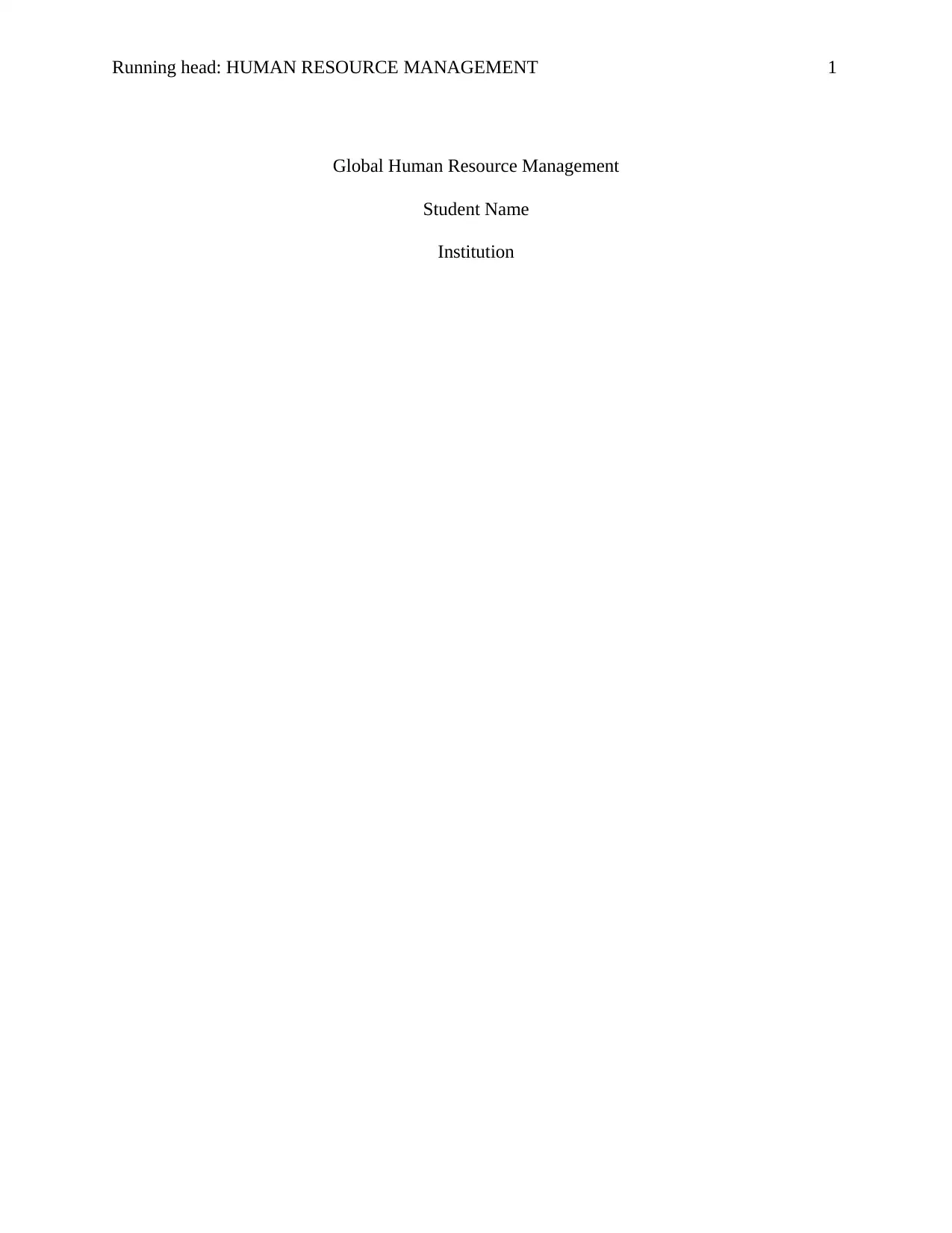
Running head: HUMAN RESOURCE MANAGEMENT 1
Global Human Resource Management
Student Name
Institution
Global Human Resource Management
Student Name
Institution
Paraphrase This Document
Need a fresh take? Get an instant paraphrase of this document with our AI Paraphraser
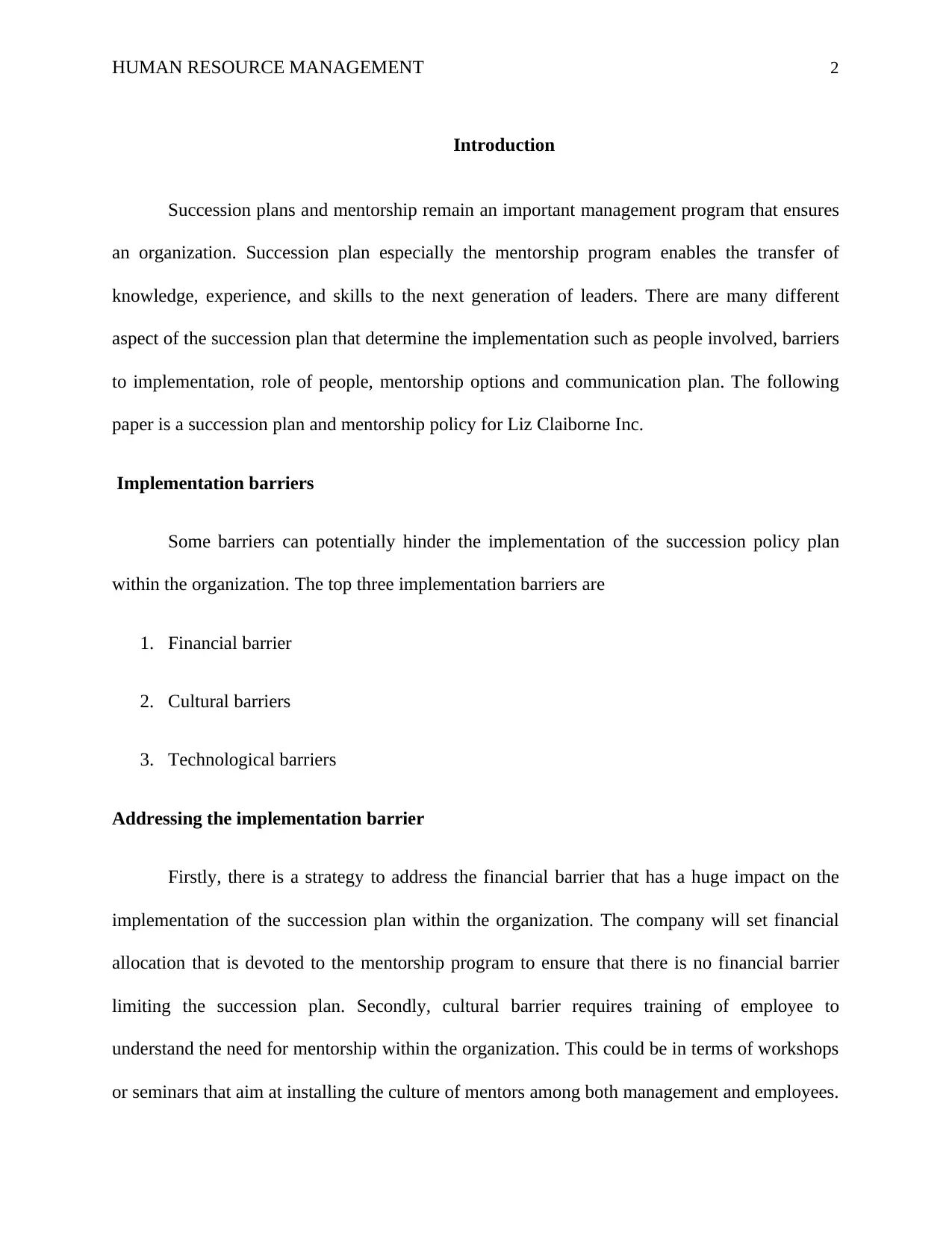
HUMAN RESOURCE MANAGEMENT 2
Introduction
Succession plans and mentorship remain an important management program that ensures
an organization. Succession plan especially the mentorship program enables the transfer of
knowledge, experience, and skills to the next generation of leaders. There are many different
aspect of the succession plan that determine the implementation such as people involved, barriers
to implementation, role of people, mentorship options and communication plan. The following
paper is a succession plan and mentorship policy for Liz Claiborne Inc.
Implementation barriers
Some barriers can potentially hinder the implementation of the succession policy plan
within the organization. The top three implementation barriers are
1. Financial barrier
2. Cultural barriers
3. Technological barriers
Addressing the implementation barrier
Firstly, there is a strategy to address the financial barrier that has a huge impact on the
implementation of the succession plan within the organization. The company will set financial
allocation that is devoted to the mentorship program to ensure that there is no financial barrier
limiting the succession plan. Secondly, cultural barrier requires training of employee to
understand the need for mentorship within the organization. This could be in terms of workshops
or seminars that aim at installing the culture of mentors among both management and employees.
Introduction
Succession plans and mentorship remain an important management program that ensures
an organization. Succession plan especially the mentorship program enables the transfer of
knowledge, experience, and skills to the next generation of leaders. There are many different
aspect of the succession plan that determine the implementation such as people involved, barriers
to implementation, role of people, mentorship options and communication plan. The following
paper is a succession plan and mentorship policy for Liz Claiborne Inc.
Implementation barriers
Some barriers can potentially hinder the implementation of the succession policy plan
within the organization. The top three implementation barriers are
1. Financial barrier
2. Cultural barriers
3. Technological barriers
Addressing the implementation barrier
Firstly, there is a strategy to address the financial barrier that has a huge impact on the
implementation of the succession plan within the organization. The company will set financial
allocation that is devoted to the mentorship program to ensure that there is no financial barrier
limiting the succession plan. Secondly, cultural barrier requires training of employee to
understand the need for mentorship within the organization. This could be in terms of workshops
or seminars that aim at installing the culture of mentors among both management and employees.
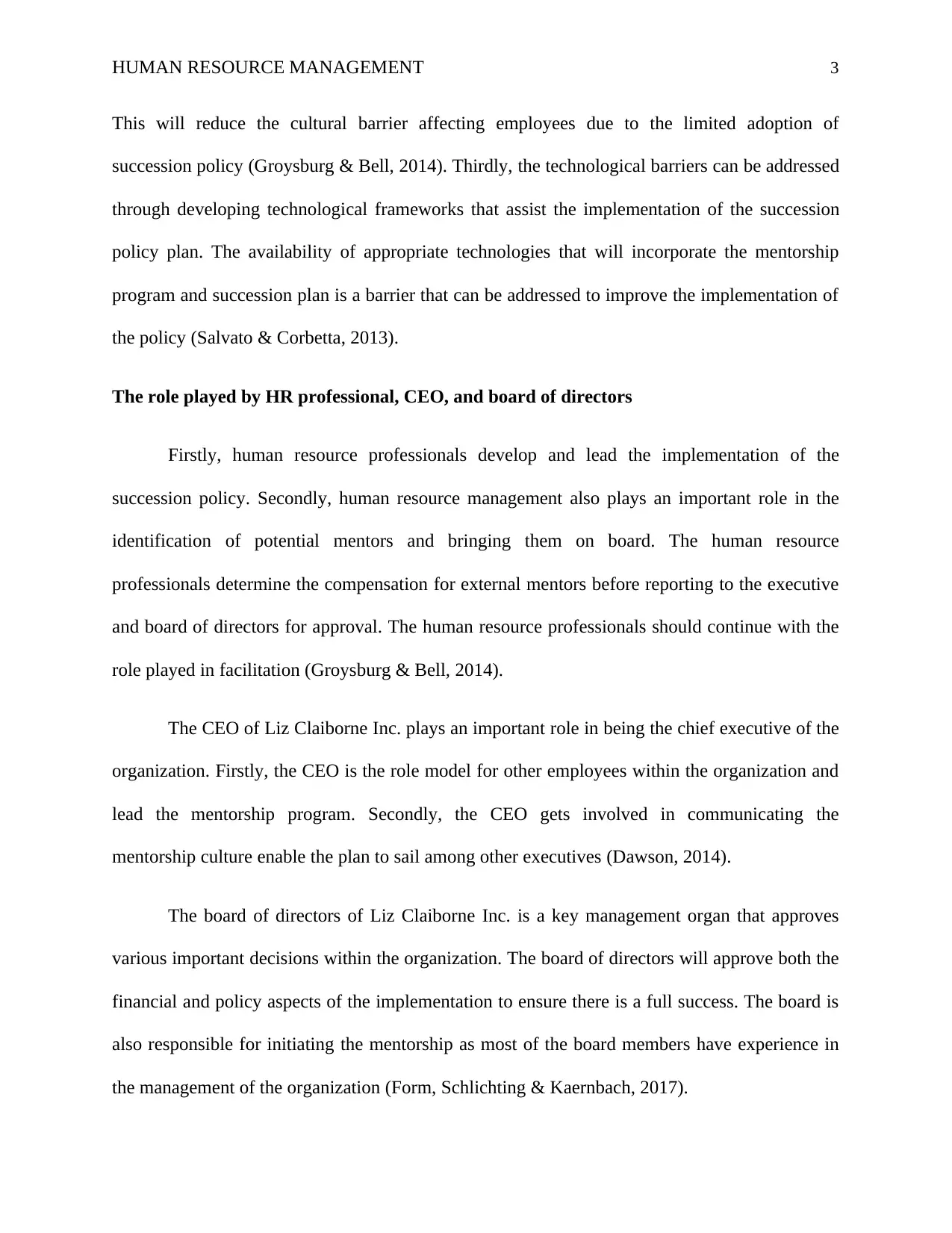
HUMAN RESOURCE MANAGEMENT 3
This will reduce the cultural barrier affecting employees due to the limited adoption of
succession policy (Groysburg & Bell, 2014). Thirdly, the technological barriers can be addressed
through developing technological frameworks that assist the implementation of the succession
policy plan. The availability of appropriate technologies that will incorporate the mentorship
program and succession plan is a barrier that can be addressed to improve the implementation of
the policy (Salvato & Corbetta, 2013).
The role played by HR professional, CEO, and board of directors
Firstly, human resource professionals develop and lead the implementation of the
succession policy. Secondly, human resource management also plays an important role in the
identification of potential mentors and bringing them on board. The human resource
professionals determine the compensation for external mentors before reporting to the executive
and board of directors for approval. The human resource professionals should continue with the
role played in facilitation (Groysburg & Bell, 2014).
The CEO of Liz Claiborne Inc. plays an important role in being the chief executive of the
organization. Firstly, the CEO is the role model for other employees within the organization and
lead the mentorship program. Secondly, the CEO gets involved in communicating the
mentorship culture enable the plan to sail among other executives (Dawson, 2014).
The board of directors of Liz Claiborne Inc. is a key management organ that approves
various important decisions within the organization. The board of directors will approve both the
financial and policy aspects of the implementation to ensure there is a full success. The board is
also responsible for initiating the mentorship as most of the board members have experience in
the management of the organization (Form, Schlichting & Kaernbach, 2017).
This will reduce the cultural barrier affecting employees due to the limited adoption of
succession policy (Groysburg & Bell, 2014). Thirdly, the technological barriers can be addressed
through developing technological frameworks that assist the implementation of the succession
policy plan. The availability of appropriate technologies that will incorporate the mentorship
program and succession plan is a barrier that can be addressed to improve the implementation of
the policy (Salvato & Corbetta, 2013).
The role played by HR professional, CEO, and board of directors
Firstly, human resource professionals develop and lead the implementation of the
succession policy. Secondly, human resource management also plays an important role in the
identification of potential mentors and bringing them on board. The human resource
professionals determine the compensation for external mentors before reporting to the executive
and board of directors for approval. The human resource professionals should continue with the
role played in facilitation (Groysburg & Bell, 2014).
The CEO of Liz Claiborne Inc. plays an important role in being the chief executive of the
organization. Firstly, the CEO is the role model for other employees within the organization and
lead the mentorship program. Secondly, the CEO gets involved in communicating the
mentorship culture enable the plan to sail among other executives (Dawson, 2014).
The board of directors of Liz Claiborne Inc. is a key management organ that approves
various important decisions within the organization. The board of directors will approve both the
financial and policy aspects of the implementation to ensure there is a full success. The board is
also responsible for initiating the mentorship as most of the board members have experience in
the management of the organization (Form, Schlichting & Kaernbach, 2017).
⊘ This is a preview!⊘
Do you want full access?
Subscribe today to unlock all pages.

Trusted by 1+ million students worldwide
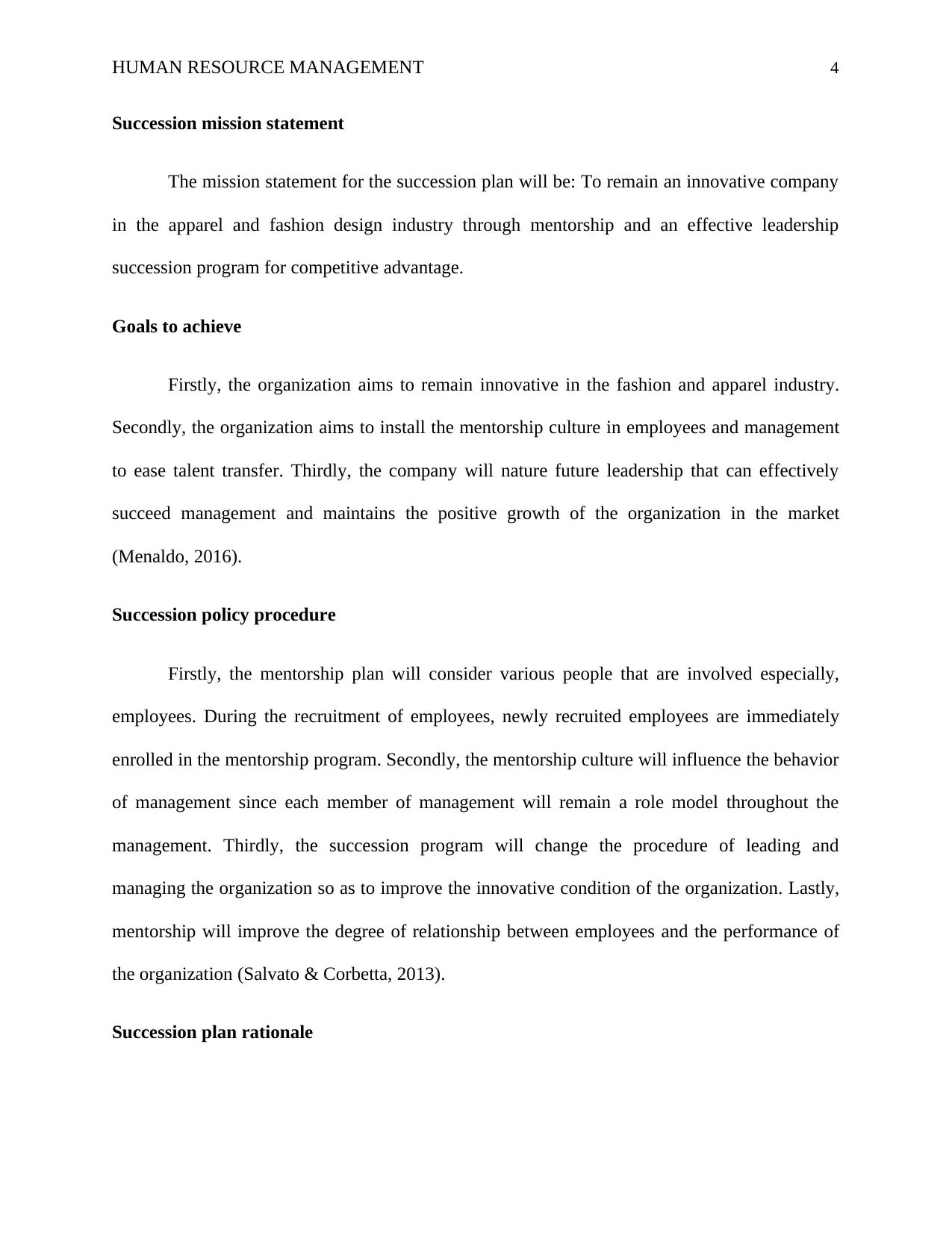
HUMAN RESOURCE MANAGEMENT 4
Succession mission statement
The mission statement for the succession plan will be: To remain an innovative company
in the apparel and fashion design industry through mentorship and an effective leadership
succession program for competitive advantage.
Goals to achieve
Firstly, the organization aims to remain innovative in the fashion and apparel industry.
Secondly, the organization aims to install the mentorship culture in employees and management
to ease talent transfer. Thirdly, the company will nature future leadership that can effectively
succeed management and maintains the positive growth of the organization in the market
(Menaldo, 2016).
Succession policy procedure
Firstly, the mentorship plan will consider various people that are involved especially,
employees. During the recruitment of employees, newly recruited employees are immediately
enrolled in the mentorship program. Secondly, the mentorship culture will influence the behavior
of management since each member of management will remain a role model throughout the
management. Thirdly, the succession program will change the procedure of leading and
managing the organization so as to improve the innovative condition of the organization. Lastly,
mentorship will improve the degree of relationship between employees and the performance of
the organization (Salvato & Corbetta, 2013).
Succession plan rationale
Succession mission statement
The mission statement for the succession plan will be: To remain an innovative company
in the apparel and fashion design industry through mentorship and an effective leadership
succession program for competitive advantage.
Goals to achieve
Firstly, the organization aims to remain innovative in the fashion and apparel industry.
Secondly, the organization aims to install the mentorship culture in employees and management
to ease talent transfer. Thirdly, the company will nature future leadership that can effectively
succeed management and maintains the positive growth of the organization in the market
(Menaldo, 2016).
Succession policy procedure
Firstly, the mentorship plan will consider various people that are involved especially,
employees. During the recruitment of employees, newly recruited employees are immediately
enrolled in the mentorship program. Secondly, the mentorship culture will influence the behavior
of management since each member of management will remain a role model throughout the
management. Thirdly, the succession program will change the procedure of leading and
managing the organization so as to improve the innovative condition of the organization. Lastly,
mentorship will improve the degree of relationship between employees and the performance of
the organization (Salvato & Corbetta, 2013).
Succession plan rationale
Paraphrase This Document
Need a fresh take? Get an instant paraphrase of this document with our AI Paraphraser
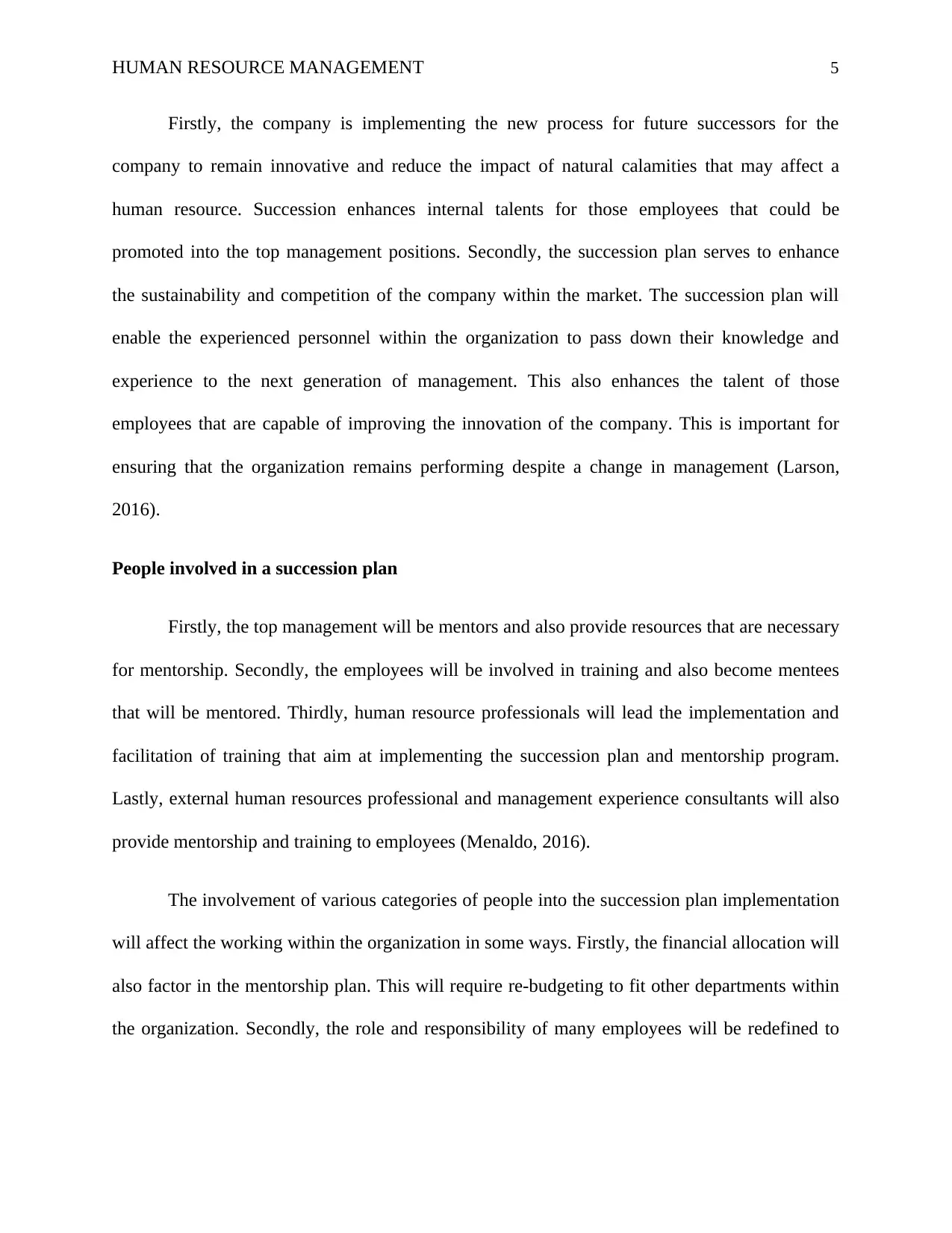
HUMAN RESOURCE MANAGEMENT 5
Firstly, the company is implementing the new process for future successors for the
company to remain innovative and reduce the impact of natural calamities that may affect a
human resource. Succession enhances internal talents for those employees that could be
promoted into the top management positions. Secondly, the succession plan serves to enhance
the sustainability and competition of the company within the market. The succession plan will
enable the experienced personnel within the organization to pass down their knowledge and
experience to the next generation of management. This also enhances the talent of those
employees that are capable of improving the innovation of the company. This is important for
ensuring that the organization remains performing despite a change in management (Larson,
2016).
People involved in a succession plan
Firstly, the top management will be mentors and also provide resources that are necessary
for mentorship. Secondly, the employees will be involved in training and also become mentees
that will be mentored. Thirdly, human resource professionals will lead the implementation and
facilitation of training that aim at implementing the succession plan and mentorship program.
Lastly, external human resources professional and management experience consultants will also
provide mentorship and training to employees (Menaldo, 2016).
The involvement of various categories of people into the succession plan implementation
will affect the working within the organization in some ways. Firstly, the financial allocation will
also factor in the mentorship plan. This will require re-budgeting to fit other departments within
the organization. Secondly, the role and responsibility of many employees will be redefined to
Firstly, the company is implementing the new process for future successors for the
company to remain innovative and reduce the impact of natural calamities that may affect a
human resource. Succession enhances internal talents for those employees that could be
promoted into the top management positions. Secondly, the succession plan serves to enhance
the sustainability and competition of the company within the market. The succession plan will
enable the experienced personnel within the organization to pass down their knowledge and
experience to the next generation of management. This also enhances the talent of those
employees that are capable of improving the innovation of the company. This is important for
ensuring that the organization remains performing despite a change in management (Larson,
2016).
People involved in a succession plan
Firstly, the top management will be mentors and also provide resources that are necessary
for mentorship. Secondly, the employees will be involved in training and also become mentees
that will be mentored. Thirdly, human resource professionals will lead the implementation and
facilitation of training that aim at implementing the succession plan and mentorship program.
Lastly, external human resources professional and management experience consultants will also
provide mentorship and training to employees (Menaldo, 2016).
The involvement of various categories of people into the succession plan implementation
will affect the working within the organization in some ways. Firstly, the financial allocation will
also factor in the mentorship plan. This will require re-budgeting to fit other departments within
the organization. Secondly, the role and responsibility of many employees will be redefined to
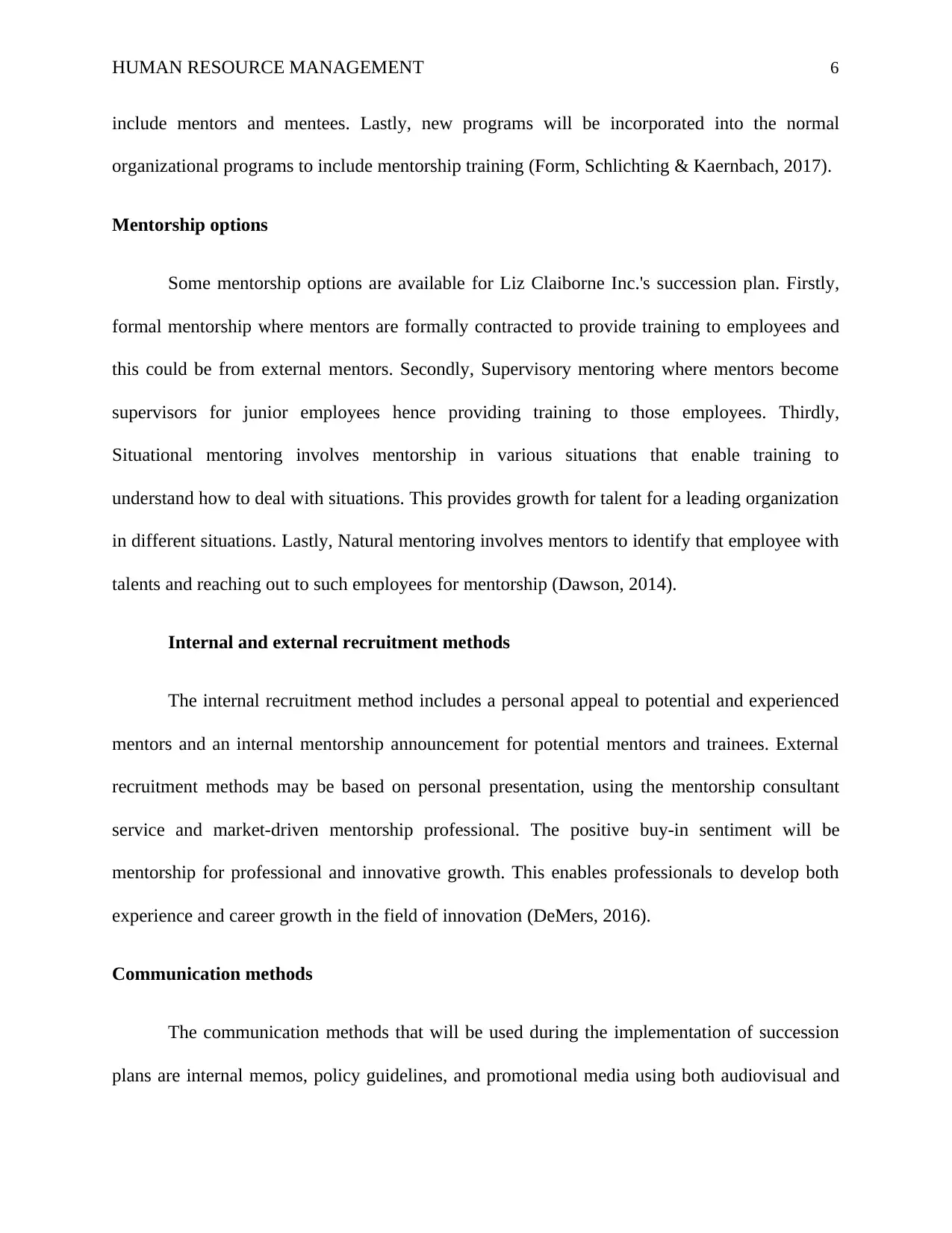
HUMAN RESOURCE MANAGEMENT 6
include mentors and mentees. Lastly, new programs will be incorporated into the normal
organizational programs to include mentorship training (Form, Schlichting & Kaernbach, 2017).
Mentorship options
Some mentorship options are available for Liz Claiborne Inc.'s succession plan. Firstly,
formal mentorship where mentors are formally contracted to provide training to employees and
this could be from external mentors. Secondly, Supervisory mentoring where mentors become
supervisors for junior employees hence providing training to those employees. Thirdly,
Situational mentoring involves mentorship in various situations that enable training to
understand how to deal with situations. This provides growth for talent for a leading organization
in different situations. Lastly, Natural mentoring involves mentors to identify that employee with
talents and reaching out to such employees for mentorship (Dawson, 2014).
Internal and external recruitment methods
The internal recruitment method includes a personal appeal to potential and experienced
mentors and an internal mentorship announcement for potential mentors and trainees. External
recruitment methods may be based on personal presentation, using the mentorship consultant
service and market-driven mentorship professional. The positive buy-in sentiment will be
mentorship for professional and innovative growth. This enables professionals to develop both
experience and career growth in the field of innovation (DeMers, 2016).
Communication methods
The communication methods that will be used during the implementation of succession
plans are internal memos, policy guidelines, and promotional media using both audiovisual and
include mentors and mentees. Lastly, new programs will be incorporated into the normal
organizational programs to include mentorship training (Form, Schlichting & Kaernbach, 2017).
Mentorship options
Some mentorship options are available for Liz Claiborne Inc.'s succession plan. Firstly,
formal mentorship where mentors are formally contracted to provide training to employees and
this could be from external mentors. Secondly, Supervisory mentoring where mentors become
supervisors for junior employees hence providing training to those employees. Thirdly,
Situational mentoring involves mentorship in various situations that enable training to
understand how to deal with situations. This provides growth for talent for a leading organization
in different situations. Lastly, Natural mentoring involves mentors to identify that employee with
talents and reaching out to such employees for mentorship (Dawson, 2014).
Internal and external recruitment methods
The internal recruitment method includes a personal appeal to potential and experienced
mentors and an internal mentorship announcement for potential mentors and trainees. External
recruitment methods may be based on personal presentation, using the mentorship consultant
service and market-driven mentorship professional. The positive buy-in sentiment will be
mentorship for professional and innovative growth. This enables professionals to develop both
experience and career growth in the field of innovation (DeMers, 2016).
Communication methods
The communication methods that will be used during the implementation of succession
plans are internal memos, policy guidelines, and promotional media using both audiovisual and
⊘ This is a preview!⊘
Do you want full access?
Subscribe today to unlock all pages.

Trusted by 1+ million students worldwide
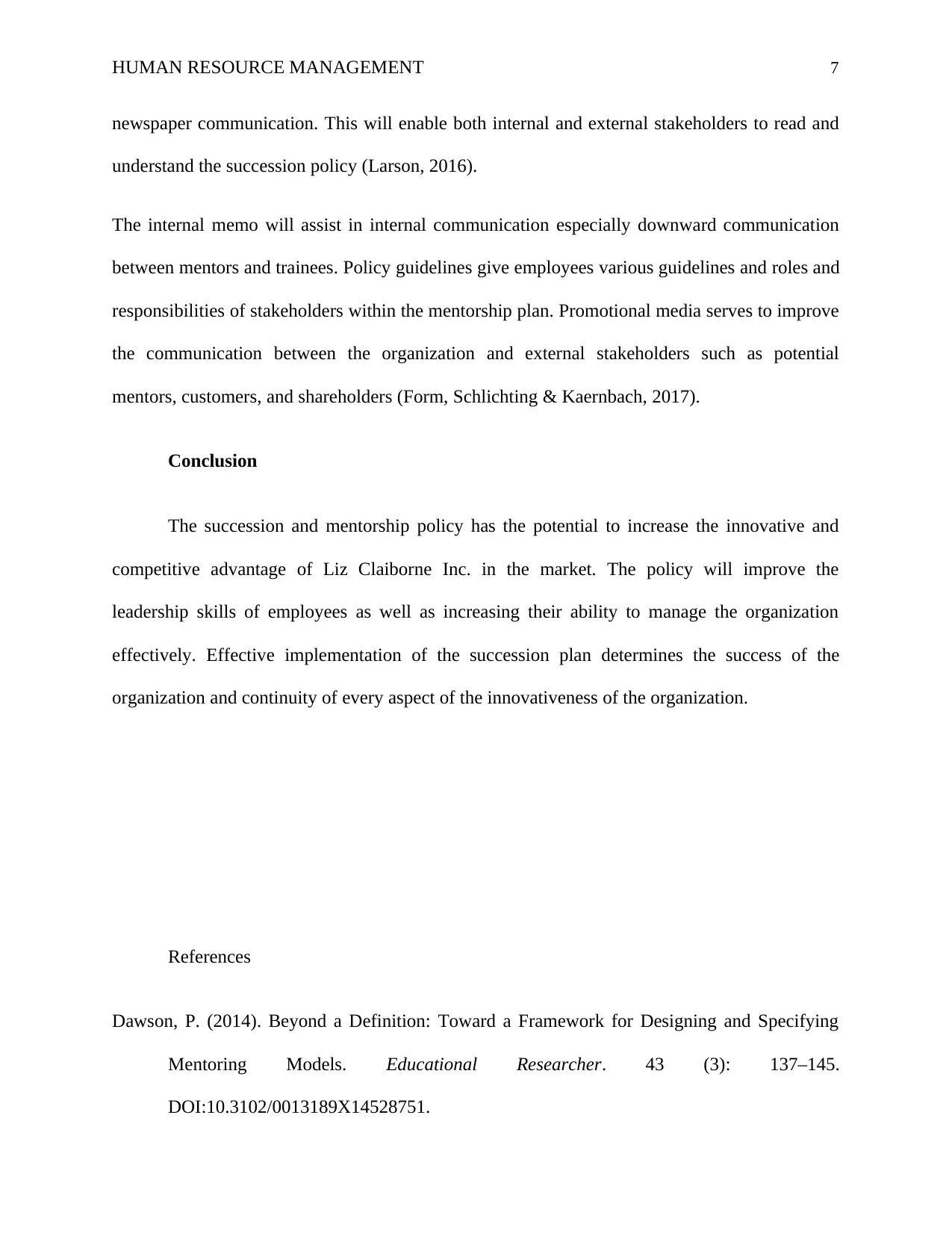
HUMAN RESOURCE MANAGEMENT 7
newspaper communication. This will enable both internal and external stakeholders to read and
understand the succession policy (Larson, 2016).
The internal memo will assist in internal communication especially downward communication
between mentors and trainees. Policy guidelines give employees various guidelines and roles and
responsibilities of stakeholders within the mentorship plan. Promotional media serves to improve
the communication between the organization and external stakeholders such as potential
mentors, customers, and shareholders (Form, Schlichting & Kaernbach, 2017).
Conclusion
The succession and mentorship policy has the potential to increase the innovative and
competitive advantage of Liz Claiborne Inc. in the market. The policy will improve the
leadership skills of employees as well as increasing their ability to manage the organization
effectively. Effective implementation of the succession plan determines the success of the
organization and continuity of every aspect of the innovativeness of the organization.
References
Dawson, P. (2014). Beyond a Definition: Toward a Framework for Designing and Specifying
Mentoring Models. Educational Researcher. 43 (3): 137–145.
DOI:10.3102/0013189X14528751.
newspaper communication. This will enable both internal and external stakeholders to read and
understand the succession policy (Larson, 2016).
The internal memo will assist in internal communication especially downward communication
between mentors and trainees. Policy guidelines give employees various guidelines and roles and
responsibilities of stakeholders within the mentorship plan. Promotional media serves to improve
the communication between the organization and external stakeholders such as potential
mentors, customers, and shareholders (Form, Schlichting & Kaernbach, 2017).
Conclusion
The succession and mentorship policy has the potential to increase the innovative and
competitive advantage of Liz Claiborne Inc. in the market. The policy will improve the
leadership skills of employees as well as increasing their ability to manage the organization
effectively. Effective implementation of the succession plan determines the success of the
organization and continuity of every aspect of the innovativeness of the organization.
References
Dawson, P. (2014). Beyond a Definition: Toward a Framework for Designing and Specifying
Mentoring Models. Educational Researcher. 43 (3): 137–145.
DOI:10.3102/0013189X14528751.
Paraphrase This Document
Need a fresh take? Get an instant paraphrase of this document with our AI Paraphraser
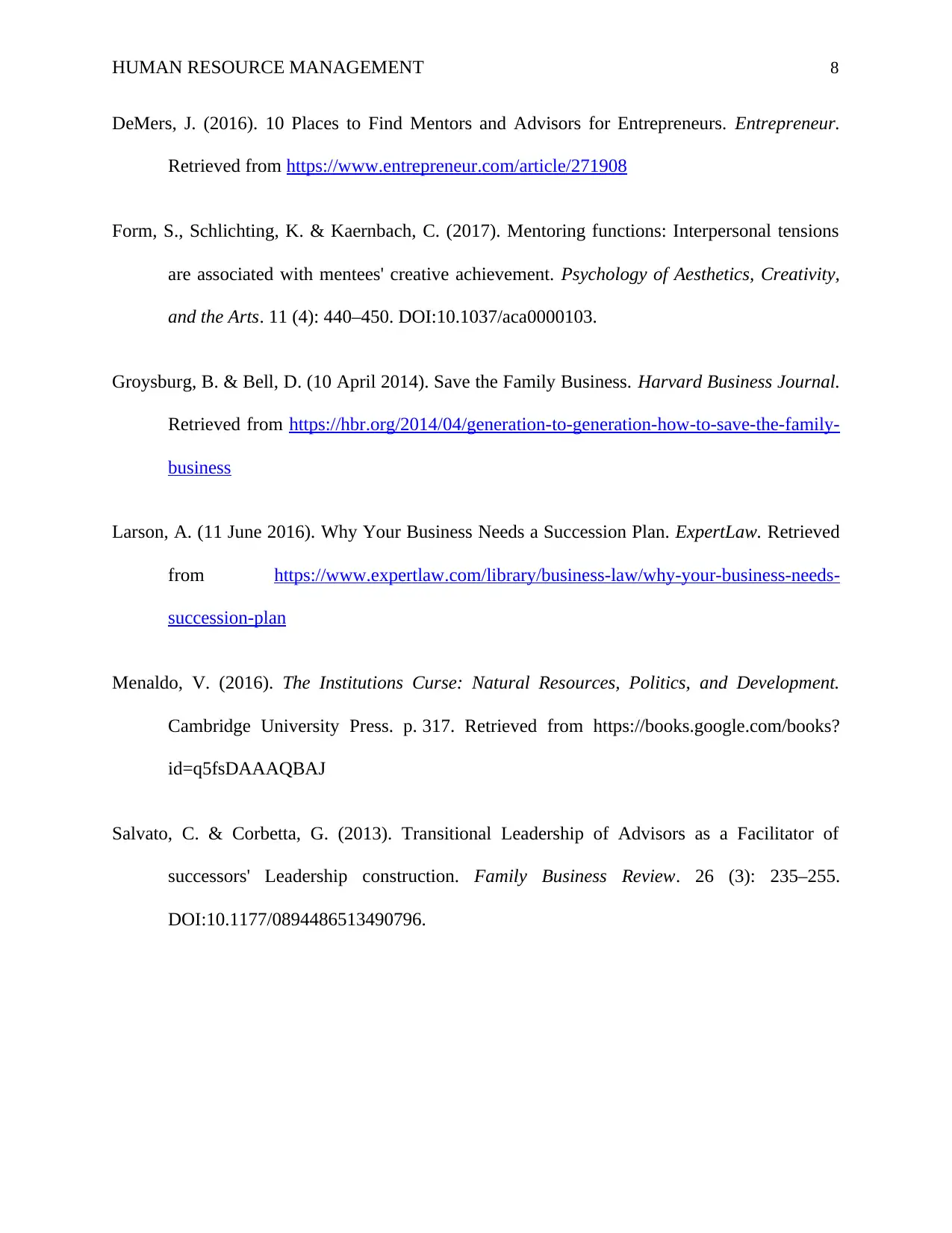
HUMAN RESOURCE MANAGEMENT 8
DeMers, J. (2016). 10 Places to Find Mentors and Advisors for Entrepreneurs. Entrepreneur.
Retrieved from https://www.entrepreneur.com/article/271908
Form, S., Schlichting, K. & Kaernbach, C. (2017). Mentoring functions: Interpersonal tensions
are associated with mentees' creative achievement. Psychology of Aesthetics, Creativity,
and the Arts. 11 (4): 440–450. DOI:10.1037/aca0000103.
Groysburg, B. & Bell, D. (10 April 2014). Save the Family Business. Harvard Business Journal.
Retrieved from https://hbr.org/2014/04/generation-to-generation-how-to-save-the-family-
business
Larson, A. (11 June 2016). Why Your Business Needs a Succession Plan. ExpertLaw. Retrieved
from https://www.expertlaw.com/library/business-law/why-your-business-needs-
succession-plan
Menaldo, V. (2016). The Institutions Curse: Natural Resources, Politics, and Development.
Cambridge University Press. p. 317. Retrieved from https://books.google.com/books?
id=q5fsDAAAQBAJ
Salvato, C. & Corbetta, G. (2013). Transitional Leadership of Advisors as a Facilitator of
successors' Leadership construction. Family Business Review. 26 (3): 235–255.
DOI:10.1177/0894486513490796.
DeMers, J. (2016). 10 Places to Find Mentors and Advisors for Entrepreneurs. Entrepreneur.
Retrieved from https://www.entrepreneur.com/article/271908
Form, S., Schlichting, K. & Kaernbach, C. (2017). Mentoring functions: Interpersonal tensions
are associated with mentees' creative achievement. Psychology of Aesthetics, Creativity,
and the Arts. 11 (4): 440–450. DOI:10.1037/aca0000103.
Groysburg, B. & Bell, D. (10 April 2014). Save the Family Business. Harvard Business Journal.
Retrieved from https://hbr.org/2014/04/generation-to-generation-how-to-save-the-family-
business
Larson, A. (11 June 2016). Why Your Business Needs a Succession Plan. ExpertLaw. Retrieved
from https://www.expertlaw.com/library/business-law/why-your-business-needs-
succession-plan
Menaldo, V. (2016). The Institutions Curse: Natural Resources, Politics, and Development.
Cambridge University Press. p. 317. Retrieved from https://books.google.com/books?
id=q5fsDAAAQBAJ
Salvato, C. & Corbetta, G. (2013). Transitional Leadership of Advisors as a Facilitator of
successors' Leadership construction. Family Business Review. 26 (3): 235–255.
DOI:10.1177/0894486513490796.
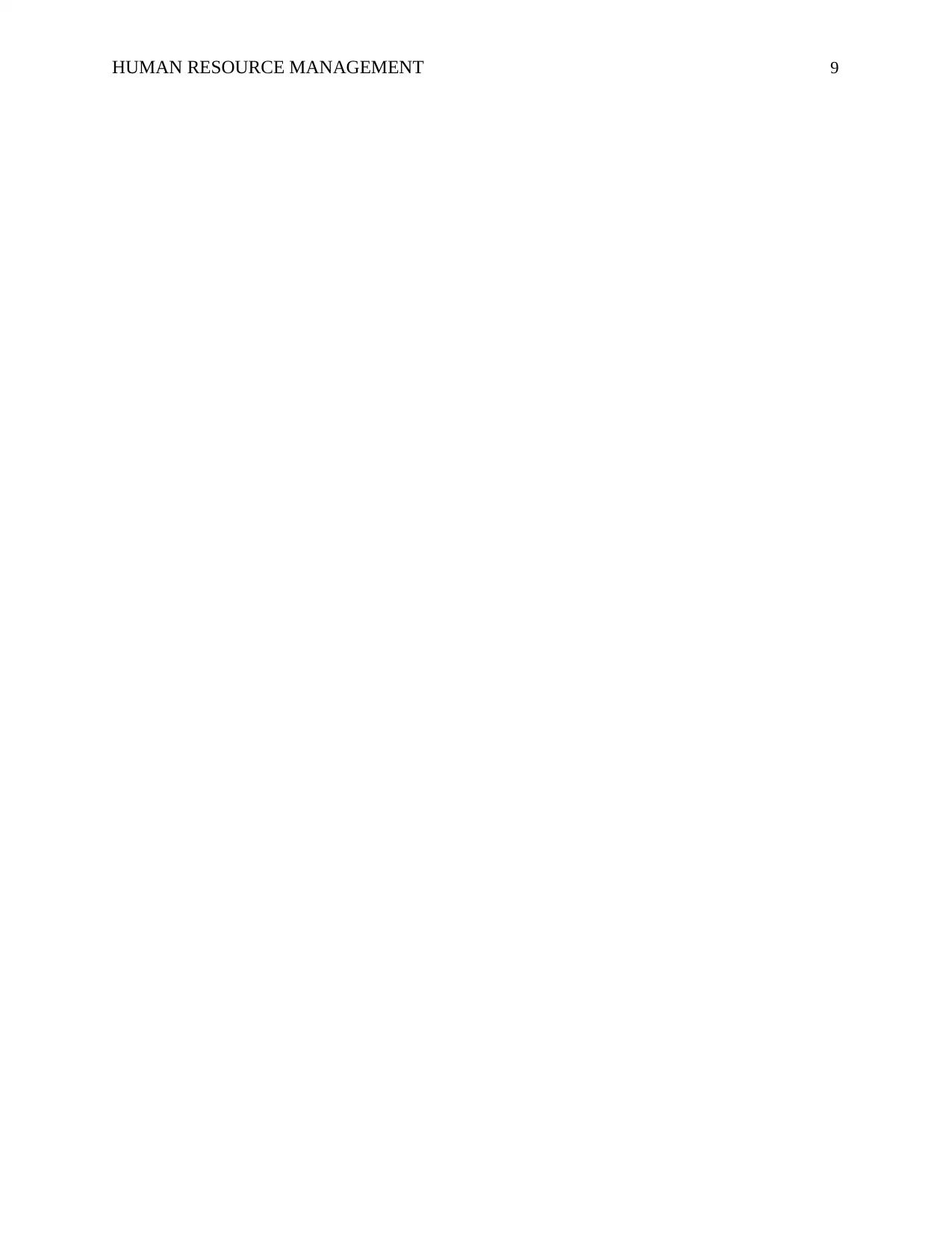
HUMAN RESOURCE MANAGEMENT 9
⊘ This is a preview!⊘
Do you want full access?
Subscribe today to unlock all pages.

Trusted by 1+ million students worldwide
1 out of 9
Related Documents
Your All-in-One AI-Powered Toolkit for Academic Success.
+13062052269
info@desklib.com
Available 24*7 on WhatsApp / Email
![[object Object]](/_next/static/media/star-bottom.7253800d.svg)
Unlock your academic potential
Copyright © 2020–2025 A2Z Services. All Rights Reserved. Developed and managed by ZUCOL.





